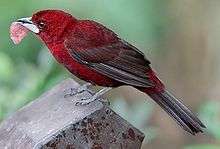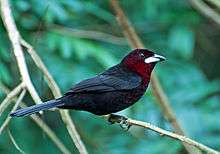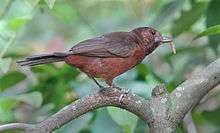Silver-beaked tanager
The silver-beaked tanager (Ramphocelus carbo) is a medium-sized passerine bird. This tanager is a resident breeder in South America from eastern Colombia and Venezuela south to Paraguay and central Brazil, Perú and on Trinidad. It is common and conspicuous.

| Silver-beaked tanager | |
|---|---|
 | |
| Male in São Paulo, Brazil | |
 | |
| Female | |
| Scientific classification | |
| Kingdom: | Animalia |
| Phylum: | Chordata |
| Class: | Aves |
| Order: | Passeriformes |
| Family: | Thraupidae |
| Genus: | Ramphocelus |
| Species: | R. carbo |
| Binomial name | |
| Ramphocelus carbo (Pallas, 1764) | |
| Synonyms | |
| |
Silver-beaked tanagers are 18 centimetres (7 in) long and weigh 25 grams (0.88 oz). Adult males are velvety crimson black with a deep crimson throat and breast. The upper mandible of the bill is black, but the enlarged lower mandible is bright silver in appearance. The bill is pointed upwards in display. The female is much duller, with brownish upperparts, reddish brown underparts and a black bill.
There is considerable plumage variation between the various subspecies, differing mainly in the degree of contrast between the upperparts and the throat and breast.
It occurs in light woodland and cultivated areas. The bulky cup nest is usually built in a bush, and the normal clutch is two green-blue eggs blotched with black-brown. The female incubates the eggs for 11–13 days before they hatch.[2] The chicks fledge after another 11–12 days.
Individuals may live at least 11 years in the wild.[3]
These are social birds which eat mainly fruit, but insects are also taken. The silver-beaked tanager is often seen in groups of six to ten, frequently giving a call described as cheeng. Its song is a slow thin kick-wick.
The silver-beaked tanager was first described by the German naturalist Peter Simon Pallas in 1764 and given the binomial name Lanius carbo.[4][5][6]
References
- BirdLife International (2012). "Ramphocelus carbo". IUCN Red List of Threatened Species. 2012. Retrieved 26 November 2013.CS1 maint: ref=harv (link)
- Lima, Jônatas; Guiherme, Edson (22 June 2020). "Breeding biology and biometrics of Silver-beaked Tanager Ramphocelus carbo connectens in south-west Brazilian Amazonia". Bulletin of the British Ornithologists' Club. 140 (2): 170-181. doi:10.25226/bboc.v140i2.2020.a8.
- Lima, Jônatas; Guiherme, Edson (22 June 2020). "Breeding biology and biometrics of Silver-beaked Tanager Ramphocelus carbo connectens in south-west Brazilian Amazonia". Bulletin of the British Ornithologists' Club. 140 (2): 170-181. doi:10.25226/bboc.v140i2.2020.a8.
- Paynter, Raymond A. Jnr (1970). Check-list of Birds of the World. Volume 13. Cambridge, Massachusetts: Museum of Comparative Zoology. p. 313.
- Sherborn, C. Davies (1905). "The new species of birds in Vroeg's catalogue, 1764". Smithsonian Miscellaneous Collections. 47: 332–341 [335 Nos. 114 & 115]. Includes a transcript of the 1764 text.
- Rookmaaker, L.C.; Pieters, F.F.J.M. (2000). "Birds in the sales catalogue of Adriaan Vroeg (1764) described by Pallas and Vosmaer". Contributions to Zoology. 69 (4): 271–277.
- ffrench, Richard (1991). A Guide to the Birds of Trinidad and Tobago (2nd ed.). Comstock Publishing. ISBN 0-8014-9792-2.
- Hilty, Steven L (2003). Birds of Venezuela. London: Christopher Helm. ISBN 0-7136-6418-5.
External links
![]()
![]()
- Page with photos and a sound file – from the Birds of Suriname
- Silver-beaked Tanager videos, photos & sounds on the Internet Bird Collection
- Stamps (for Suriname) with RangeMap
- Photo; Article – borderland-tours
- Silver-beaked Tanager photo gallery VIREO Photo-High Res-(shows black/ silver bill)
